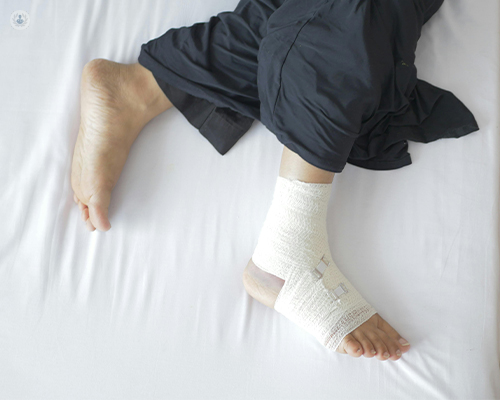Putting the best foot forward: what you should know about diabetic foot
Escrito por:Diabetes can affect the foot in a variety of ways. This includes infections, ulcers, and a condition called Charcot foot, where the bones become softer than normal, making it susceptible to fractures and dislocations. Issues with the foot may be unnoticed for a time, as sensation is impaired due to nerve damage from diabetes. A leading consultant orthopaedic surgeon explains all about this condition in this article.

What is diabetic foot?
Diabetic foot is an accompanying condition to diabetes, and is most common with type 2 diabetes. Diabetic foot happens because of a high blood sugar level, caused by a build-up of glucose, which is damaging to the nerves and blood vessels of the foot.
In severe cases of diabetic foot, the toes can darken to black due to a lack of blood flow to the extremities. Early warning signs include excessive blisters, calluses, and small injuries, that can cumulate into sores and infections. Because of the lack of sensation and blood flow, small cuts can take longer to heal and worsen easily. Diabetes reduces the immune system’s ability to fight against infections.
What are the effects of diabetic foot?
Nerve damage, called diabetic neuropathy in this case, is when sensation is not felt correctly or at all in the feet. A sensation like pain, though uncomfortable, is important because it is a way to signal to the brain that something has gone wrong in a part of the body. Without pain, we wouldn’t know if a bone is broken, if a muscle has been torn, or if we have a cut somewhere without seeing it. In the diabetic foot, neuropathy means that blisters, cuts, and ulcers may go unnoticed. These wounds can then get infected.
Diabetes can also impair blood flow due to high blood sugar causing fatty deposits in the blood vessels. In blood, white blood cells fight foreign bacteria and fungi, red blood cells carry oxygen which powers the tissues and muscles, and platelets are used to form scabs to stop bleeding and allow the skin time to knit back together. Without adequate blood flow, healing is slower and infections last longer. These infections can worsen into conditions such as gangrene, where the tissues begin to die, and at its worst, it can lead to necessitating an amputation in order to stop the spread of infection.
Charcot foot is a complication that arises in diabetes cases when there’s neuropathy in the foot where the bones become fragile and can dislocate or break very easily. The bones can shift around and the distribution of weight may change, putting more pressure on certain parts of the foot and further exacerbating ulcers and infection. Charcot foot can be accompanied by swelling and redness, but as there is reduced sensation in the foot, a patient may not realise how severe the condition of their foot is unless they were to do a thorough investigation.
With consideration to the prevalence of comorbidity of diabetes with obesity, this pressure put on the foot can be great, and examinations may be difficult to achieve without assistance.
How to protect the feet with diabetes
Aside from regular diabetes management and treatment, patients are encouraged to be diligent with monitoring the condition of their feet, daily if possible, practice good hygiene and grooming practices for the feet, and wear supportive shoes and quality socks that aren’t too tight. Keep the blood flow in the feet by putting feet up when sitting, flexing the toes and rotating the ankles throughout the day, and engaging in regular physical activity.
If the foot is infected, then the patient may be prescribed antibiotics that can be taken orally or intravenously. If it is severe, then it may need a procedure called debridement to excise dead and infected tissue to promote healing.
The deformities of the foot can be managed, if not too advanced, with a corrective medical boot obtained or prescribed footwear from a podiatrist. Any damage or injury to the foot that doesn’t start to heal within a few days should be brought to the attention of the doctor.
If you think you may have diabetic foot, you can book a consultation with a specialist today via Top Doctors.


